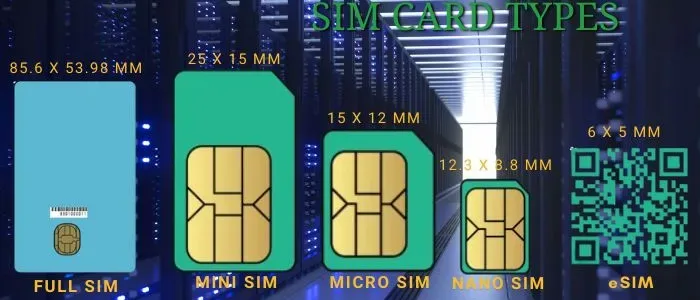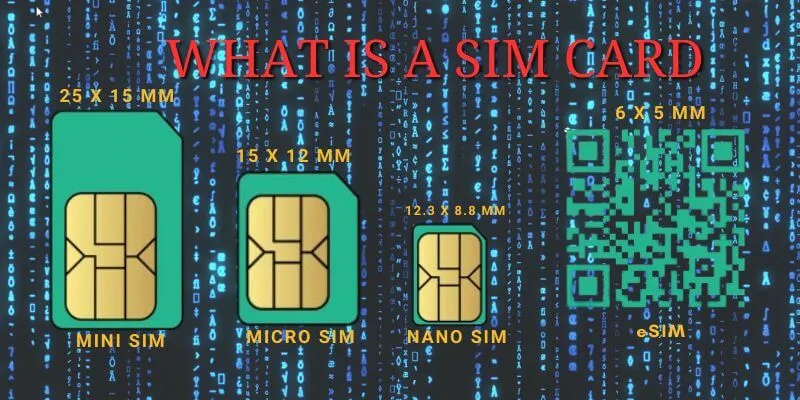We live in a connected world and mobile devices are a very important part of our daily lives now. Staying connected constantly is almost expected these days, and also keeps us connected to the people we love. In a way, our mobile devices keep the link between us and the rest of the world intact and that was made possible thanks to the SIM card.
A Subscriber Identity Module, commonly known as a SIM card. This is a PVC/ plastic card with an embedded GSM chip that slots into your phone and is used to store user information to enable identification for connectivity of your mobile device to the service provider’s network. Without a SIM card, your mobile device will be unable to authenticate and connect.
This ensures you can make calls, send SMS or MMS messages and use mobile data to connect to the internet through 2G(GPRS and EDGE), 3G, 4G, and 5G. Every SIM card has 2 unique identifiers known as IMSI (International Mobile Subscriber Identity) and MSISDN (Mobile Subscriber Integrated Services Digital Network Number). The IMSI is needed to identify your phone to the network and the MSISDN is in fact your phone number.
How Does The SIM Card Work?
The SIM card ensures you can authenticate and connect to your mobile network to make calls, send SMS or MMS messages and use mobile data to connect to the internet through 2G(GPRS and EDGE), 3G, 4G, and 5G. Every SIM card has 2 unique identifiers known as IMSI (International Mobile Subscriber Identity) and MSISDN (Mobile Subscriber Integrated Services Digital Network Number). The IMSI is needed to identify your phone to the network and the MSISDN is in fact your phone number.
SIM Card Storage and Capacity
The SIM card serves as the main storage for your Contacts, SMS messages and any network data. Since the 1990s, phones have had more internal memory and even external storage by way of Micro SD cards so you can now either use your SIM or Phone memory to store Contacts and SMS or MMS messages.
SIM card storage ranges from 32KB and 256KB or 512KB memory for the latest cards. At the basic level, SIM cards can store a maximum of 250 Contacts and some messages. The new generation SIm cards with hold 500 messages.
Full-Size SIM
The Full-size SIM card was the size of a credit card and had just 32 KB of memory, which was just enough to store 5 messages and 20 Contacts.
Standard or Mini-SIM
Followed by the Standard or Mini SIM card had 64KB memory, although smaller in size.
Micro SIM
The next version, Micro Sim was smaller than the Mini but had both 64KB and 128KB memory versions depending on the device it was being used in.
Nano SIM
The Nano SIM card is the most current and smallest type of SIM card but has 128KB memory and can hold up to 250 contacts. It’s also possible to buy SIM cards with 256KB memory.
SIM storage is not so important lately since newer devices have much more internal storage and cloud capabilities.
Evolution and Types Of SIM Cards
Over the years, SIM cards have gone through an evolution. The Fullsize SIM was released in 1991 and was the first of its type in the early to mid-1990s, followed by the Standard or Mini SIM card in 1996, then the Micro SIM card in 2003 and the current Nano SIM card in 2012.
However, there was a new type of SIM card released in 2016. The eSIM, is a digital SIM card. Read more about the eSIM in our post: What is an eSIM Card and How Does it Work?
Full Size SIM (1FF) Size: 85.6mm × 53.98mm × 0.76mm
Standard/ Mini-SIM (2FF) Size: 25mm x 15mm x 0.76mm
Micro-SIM (3FF) Size: 15mm x 12mm x 0.76mm
Nano-SIM (4FF) Size: 12.3mm × 8.8mm × 0.67mm
Embedded SIM eSIM (MFF2): 6mm × 5mm × 0.9mm (Digital)

Advantages of SIM Cards
Widespread Compatibility
SIM cards are widely compatible with almost all mobile devices and networks worldwide. Currently, they are also compatible and work just fine alongside the eSIM.
Easy To Swap When Your Phone Stops Working
With the SIM card, if your phone ever stops working, you can easily buy another phone and quickly swap and you are back online.
Easy To Switch Sims and Mobile Network
If you travel abroad and have no roaming in your destination country, you can purchase a local SIM until you return.
Disadvantages of SIM Cards
Security Concerns
The SIM card is designed with security in mind using data encryption and PIN. But there is the risk of a SIM swap attack which combines social engineering when criminals gather enough information, enabling a fraudster to transfer any phone number from a SIM card to a fraudulent SIM Card.
Wait Times For Replacement SIM
If you ever lose or damage your SIM card, you’ll have to visit a store or wait a few days to receive a replacement.
Potential Damage or Wear and Tear
By swapping and moving SIM cards between devices, there’s a high chance of a fault or damage at some point if the chip ever comes into contact with any excess pressure causing it to bend or snap, liquids, static, extreme heat or wear and tear through constant swapping.
Conclusion
The future of physical SIM Cards looks good as they are still very widely used which means the technology will be around for a while since the eSIM variant is yet to really gather some traction. Embedded SIMs are not compatible with most yet but that will change in the near future.
For now, these two technologies work together quite easily which means you can either use an eSIM or SiM card, but also use both at the same time and on the same device without any issues at all. If your device is compatible with the digital version, then take advantage as and when needed, if not, there is always a solution to any challenges when it comes to physical SIMs.
In case you lose your phone, your SIM is gone with it and the only way you can have all that data back is if you have backed it up. If your phone breaks and you save data on the SIM, then you can just buy a new phone, insert the SIM and you back in business. If you save your data on the phone memory it might take time to get all that data back.
For now, the choice between these two technologies often comes down to device compatibility, setup or personal preference.
Questions People Ask
Can I use an eSIM and a physical SIM at the same time?
Most modern devices allow the use of an eSIM and a physical SIM on the same phone through Dual SIM Dual Standby (DSDS) functionality. However, not all phones support this dual standby, so check your device’s specifications or manufacturer’s website to confirm its dual SIM support.
Should I store my contacts on my phone or SIM card?
The best location to store contact data will be your phone’s local storage. SIM cards are not designed to store a huge amount of data and will store a specific number of contact data. Most modern phones now have adequate local storage with cloud-backup solutions to automatically back up your data for when you lose or swap phones or devices.
